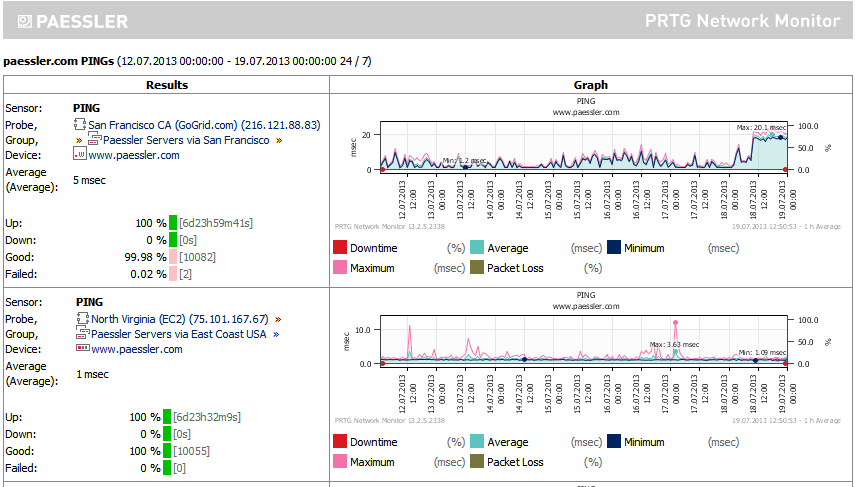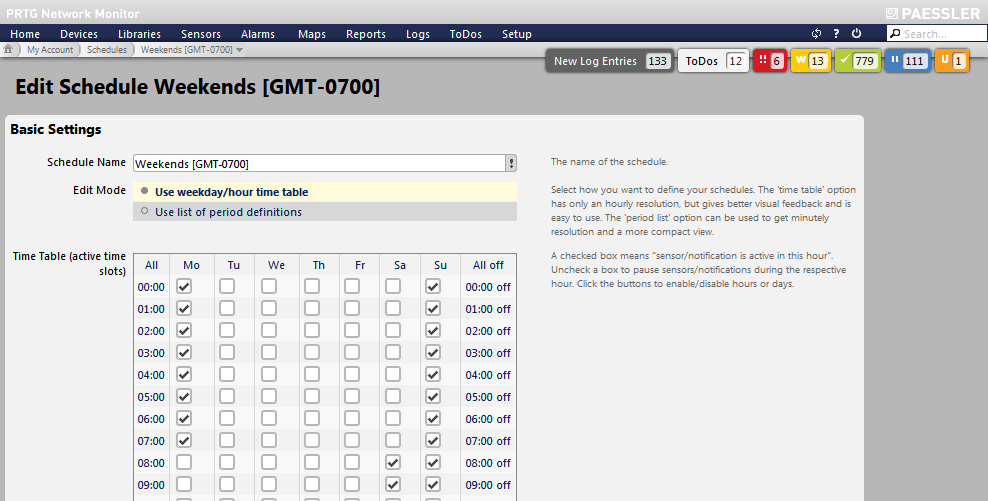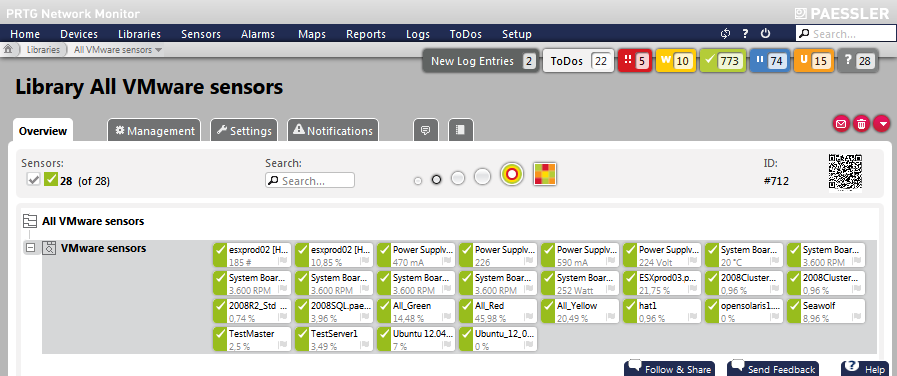White Paper: 11 Issues (inglese)
11 Everyday Network Issues PRTG Network Monitor Helps Resolve
11 Everyday Network Issues
On a normal day as a system administrator, our colleagues, supervisors, and customers constantly look to us for answers to common questions. We often field similar questions quite frequently that fall into three basic categories:
YOUR NETWORK AND ITS NEEDS AT A GLANCE
1. Why are my applications so slow and what happened to my calculation last night?
Are you planning to enhance our hardware resources soon in order to solve these
failures?
2. Why doesn't my Outlook receive any emails?
3. Why do I get alerts about downtimes of devices although my colleagues are already on
maintenance?
ENSURING THE QUALITY AND SECURITY OF YOUR NETWORK
4. Are you sure that our network is really safe and no unauthorized person is accessing it?
5. How can we be sure that our server room equipment is safe from external threats?
6. Do you know that our webpage is unacceptably slow and that customers often abandon
the buying processes?
7. Why is the sound quality of phone calls so terrible and can you please fix my
permanently lagging video streams?
KEEPING YOUR BASIC SYSTEMS RUNNING
8. Why does our database perform so poorly every morning?
9. Why does my virtual machine crash so often?
10. Can you show me the status of all my different backup solutions at a glance?
11. Why do I always have to call you ?rst when the toner of our printer is empty?
You need to address those questions quickly and in a comprehensive way. And for this, you need something that gives you the answers you need right at your fingertips.
You might already know about the many lists in PRTG that make life easier as system administrator: favorite devices, best uptime, fastest ping, highest bandwidth usage, slowest website, most available disk space, sensors with status down or by their tags, etc. You can use these to investigate the whole network to keep everything under control. But, did you know there's actually much more PRTG can do? Here is a helpful listing of eleven more everyday issues PRTG can resolve, to help you quickly address some of these most common network questions.
Your Network and its Needs at a Glance
Hardware issues and hardware enhancement
Your IT infrastructure needs a constant review in order to ensure the health of your system. Are there overloaded components, like CPU or memory, for example? Is the temperature of your servers acceptable? Are there Windows servers that restart occasionally during the night? Are you aware of this issue, or missing the clue that something is wrong? You also want to know when hard disks in your environment are nearing maximum capacity, when memory is running low, or you need to upgrade your internet connection due to increasing bandwidth usage. Knowing these network conditions will indicate when it might be time to invest in new hardware resources. PRTG provides you detailed monitoring data and historical reports about all of your network components. Analyzing these, you can see usage trends in order to predict when resources are going to run out. PRTG can also warn you with an immediate notification when something uncommon occurs, like a server outage or when certain values reach a defined threshold. This way, you can react before things get worse.
FIGURE: A report for ping sensors
Automatically reboot failing windows services and servers
When monitoring Windows services, if a service on a server fails, PRTG will send a noti?cation by SMS, email, etc. One of the most common methods for recovery is to manually reboot the whole server to get the failing service back online. The same holds true for occasional system hang-ups. In this case, Windows services will stop, PRTG recognizes this and sends a noti?cation, prompting you to reboot.
But, wouldn't it be even more effcient if the reboot could happen automatically? In fact, with PRTG's noti?cation system, it can. Simply create a script that reboots services or the whole system and invoke it to an "Execute Program" noti?cation. Once con?gured, if a service or server is down for a de?ned time span, PRTG executes this script and re-starts the service or server automatically, with no intervention. When monitoring speci?c Windows services via PRTG's WMI Service sensor, you can choose an automatic restart option even if a service is not running!
Eliminate useless and annoying alerts during
planned downtime
Sometimes it is necessary to take devices out of order for maintenance and other issues. Or, perhaps you shut down systems for the weekend or at night, or you just do not want to be noti?ed at certain times. Of course, PRTG is designed to notify you in the event of an outage to maintain maximum system availability, but receiving alerts during planned system downtime is useless. But, manually pausing monitoring of certain sensors in your big network is not worth the effort.
Fortunately, our developers implemented a dedicated feature for maintenance and other planned downtimes. For every group, device, or any other object, PRTG allows you to de?ne schedules to limit monitoring time automatically. This avoids false alarms and eliminates annoying noti?cations during planned downtime.
FIGURE: Adjustable schedules
Ensuring the Quality and Security of Your Network
Detect security issues in your network
How can you be sure that your network is safe? On the one hand, it is important that antivirus scanners are running on all computers and that they are up to date. Furthermore, you must run the latest version of Windows in order to have the latest security updates. But, in spite of those efforts, you might already be under attack.
Uncommon peaks in CPU usage and traf?c can indicate a potential attack. Fortunately, PRTG detects such unusual behavior and switches the corresponding sensors to the "unusual" status, alerting you that something may be wrong. You can also manually check connections to your network: Are there connections through your ?rewall from unknown source addresses? It's wise to routinely analyze this via the Toplists feature of several traf?c sensors to be on the safe side.
Another helpful feature for security monitoring is the Similar Sensor Analysis, which can help to recognize strange interconnections between sensors. Additionally, PRTG monitors the overall security status like the antivirus software of a Windows computer with the WMI Security Center sensor and Windows server updates with the WSUS Statistics sensor.
FIGURE: Analyzing connections via packet sniffer
Keep your data center safe
High temperatures, humidity, water leaks, ?oods, ?re, smoke, brightness-there are all kinds of potentially harmful conditions that could damage your server room or data center equipment. If the air conditioner has an outage, temperatures could quickly rise to a critical point and your servers will soon overheat. Since they cannot just run down to the corner and get an ice cream for a quick cool-down like you can, it is important for you to be proactive rather than reactive. Monitoring environmental values is important to make sure your devices are safe.
By monitoring several hardware sensors for temperature, humidity, etc., PRTG will no-tify you in the event of uncommonly high values. For example, if an APC sensor box measures more than 27°C, the applied SNMP Library sensor can show a warning status and notify you to take care of the issue. Perhaps the air conditioner is having a problem? With PRTG and a corresponding hardware sensor cable connected to the air conditioning unit, you can check it easily from your computer.
In addition to environmental factors, unauthorized persons can have a critical impact on your infrastructure's security, and of course, should not have access to sensitive areas in your of?ce. Using PRTG in combination with corresponding hardware sensors can help you ensure that all observation cameras are running, that all doors and windows are locked, and alert you to any possible problems.
Ensure availability and avoid poor performance of
web pages
Availability and loading times of web pages are a crucial point for any company-every business needs its site to be reachable day and night with acceptable performance. For online shops, it is extremely important that site requests work as expected. If a buying process fails due to technical errors or browsing items on your page is a horrible experience, you will lose customers and money. The same is true if potential customers browse by to get information about your ?rm and the page is unacceptably slow.
PRTG helps avoid possible loss of earnings for your company by alerting you immediately if anything goes wrong with your web page, or in the event of unusual behavior such as slow performance. Use the HTTP Full Web Page Sensor, for example, to monitor the loading time of the full page, or the HTTP Transaction sensor to measure loading times for performing transactions on an interactive web page. Or, add an HTTP Apache ModStatus Totals Sensor to monitor access and transferred data to identify traf?c peaks at speci?c times, so you'll know when it is time to provide more bandwidth.
FIGURE: PRTG live graph for loading times of a
web page
QoS: Sound quality in VoIP and video streaming
hiccups
When the sound quality of Voice over IP (VoIP) calls drops dramatically, or video streaming hiccups occur frequently, you need to investigate the relevant cause. Could it be jitter, packet loss, or packet delay variation of the network connection? Both VoIP and video streaming services rely heavily on a steady stream of data packets, and quality of service suffers if UDP packets are not received in a timely fashion, lost or out of order.
PRTG is the perfect tool to ?nd those issues. With the out-of-the-box Quality of Service (QoS) sensor, you can measure the quality of your network connection by sending UDP packets between two remote probes and analyzing various network parameters. You can also monitor VoIP-relevant parameters through IP Service Level Agreement (SLA) results from Cisco devices. Just add PRTG's Cisco IP SLA Sensor to ensure that your network performance is suitable for VoIP.
Keeping Your Basic Systems Running
Troubleshoot poor database performance
If database performance is low, you need to assess the cause in order to optimize performance. Unfortunately, examining the reason for bad performance of SQL servers, for example, can be a painful task.
PRTG's database maintenance support can help. For example, if SQL performance is low at speci?c times, this might be a result of overly high numbers of simultaneous user connections. The WMI Microsoft SQL Server Sensors in PRTG can show you the number of user connections and the percentage of pages found in the buffer cache without having to read from disk. If PRTG indicates this number is too low, you can increase the amount of memory available to the SQL server. Or perhaps you send inef?cient queries? PRTG measures the response time of queries and can check if the response value is the expected one.
Resolve unreliable behavior in virtual environments
It is important to continuously monitor virtual machines in highly ?exible IT infrastructures where virtualization plays a major role. Problems with virtual machines can have several causes, and PRTG provides various sensors to detect and address these issues
Adding a VMware Virtual Machine Sensor to PRTG, allows you to monitor CPU and memory usage of virtual machines via SOAP, as well as the network speed of a singlevirtual machine.
But what if speed is too slow or memory is overloaded on a VM? PRTG also enables you to monitor the host hardware, to detect immediately if problems with virtual machines originate in a host hardware failure. For example, if the general status of your VMware
host is anything other than "normal," the issue will be reported in the sensor message. Because of PRTG's dependencies feature, you can quickly determine if a single VM or the hardware is causing the problem.
FIGURE: Sensors for VMware monitoring
Ensure backup success quickly and easily
Virtualization backups. Operating system and complete image backups. SQL and Exchange backups. Tape and online backups. Even in small companies, maintaining an overview of all backups that run in your network can be dif?cult. Could you immediately answer the question: What is the current status of your NetApp storage system or your Acronis True Image backup solution?
Most backup solutions send emails indicating their status every night, but it is impractical to analyze tons of emails every morning in order to identify potential backup problems. Instead, let PRTG do it for you and reduce your workload. Simply con?gure your backup software to send emails to a dedicated email account and then set up PRTG's IMAP sensor accordingly. This way, PRTG keeps track of all your backups-and you save time while being con?dent that all backups succeeded.
Eliminate time-consuming printer maintenance
As system administrator, do you really want to waste your precious time manually checking the status of the printers in your IT infrastructure every day? It's also annoying to be interrupted during concentrated work-perhaps addressing the SQL server issues PRTG noti?ed you of recently-simply because of an empty paper tray in the printer on the ?oor above.
PRTG provides the solution: use the Windows Print Queue Sensor to monitor all jobs on a print server. If paper is running out, you receive an alert from PRTG and can react before colleagues start complaining. PRTG can even monitor hardware parameters of HP LaserJet printers with a natively available sensor. The system can send a noti?cation when the toner is low, or, even better, PRTG can automatically send an email to your supplier to bring new toners and exchange the old one. With PRTG, you can eliminate printer status worries completely, so you can concentrate on more important work.
Summary
A network monitoring solution such as PRTG Network Monitor helps an administrator to manage the challenges of his everyday work. It presents a highly advantageous supplement to a network's infrastructure and provides relief for the IT department on one hand, and is able to reveal previously unrecognized optimization possibilities on the other.
A network monitoring software which constantly monitors processes in the network, performs analysis and alerts IT personnel as soon as an error occurs or critical values are exceeded is highly recommended in order to keep track of the availability, performance and bandwidth usage in an IT network.




